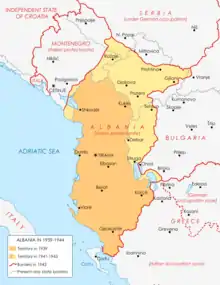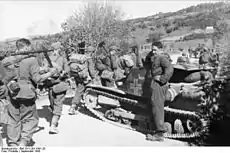Liberation Day (Albania)
Liberation Day (Albanian: Dita e Çlirimit) in Albania is commemorated as the day, November 29, 1944, in which the country was liberated from Nazi Germany forces after the Albanian resistance during World War II.[1]

Background

After Italy was defeated by the Allies, Germany occupied Albania in September 1943, dropping paratroopers into Tirana before the Albanian guerrillas could take the capital, and the German army soon drove the guerrillas into the hills and to the south. Berlin subsequently announced it would recognize the independence of a neutral Albania and organized an Albanian government, police, and military. Many Balli Kombëtar units collaborated with the Germans against the communists, and several Balli Kombëtar leaders held positions in the German-sponsored regime.[2]
The partisans entirely liberated Albania from German occupation on November 29, 1944. The National Liberation Army, which in October 1944 consisted of 70,000 regulars, also took part in the war alongside the antifascist coalition. By that time, the Soviet Army was also entering neighboring Yugoslavia, and the German Army was evacuating from Greece into Yugoslavia.
Commemoration
The holiday was first proclaimed in the early 1950s as a day of commemoration. During the era of the People's Socialist Republic of Albania, Liberation Day was the main state holiday, celebrated with a military parade of the Albanian People's Army on Tirana's Dëshmorët e Kombit Boulevard. The parade usually consisted of veterans of the UPS, schoolchildren from the local Tirana school district, Members of the People's Volunteer Guard, the Republican Guard Regiment and UPS personnel from the Directorate of State Security (Sigurimi), marching with musical accompaniment from the Band of the Albanian People's Army. It was held on jubilee years, including on the ruby jubilee in 1984 and the silver jubilee in 1969.[3][4]
A commemorative coin called "50 Qindarka" was issued by the Bank of Albania in honor of the 25th Anniversary of the Liberation of Albania. Qemal Stafa Stadium was renovated in time for the 30th anniversary in 1974. Liberation Day comes a day after the Albanian Flag Day or Independence Day commemorating the Albanian Declaration of Independence and the rise of the Albanian flag in Vlora on November 28, 1912. As a result, the celebrations are connected. The entire two day period is a non-working day.[5] Today, the holiday is celebrated with a national ceremony of some sort including the Albanian Armed Forces. A wreath laying ceremony takes place in the National Martyrs Cemetery of Albania, where 900 war dead are buried.[6] These events are held in the presence of the President of Albania, the Prime Minister, the Chairman of the Parliament, the Minister of Defense, the Chief of the Albanian General Staff and MPs of the Kuvendi.[7][8] In 2014, a military parade took place at the Ministry of Defense during the platinum jubilee of the Liberation of Albania, which included an exhibition drill and a mass inspection.[9]
Controversy
There is controversy in Albania in regards to the date: several opinion makers think that the date was chosen by the Communist Party of Albania fictitiously in order to have the same liberation date as Yugoslavia's (the day Peter II of Yugoslavia was deposed as the last King of Yugoslavia).[10] During the celebrations, war veterans often march in processions or sit at ceremonies while either carrying portraits of Enver Hoxha or performing the Hoxhaist Salute. This has become an issue due to the fact that Hoxha's legacy in the country is one of oppression and tactics that are compared to those of Mao Zedong in China or Joseph Stalin in the USSR. In one instance, during the 70th anniversary celebrations, it was reported by the Embassy of the United States, Tirana that Prime Minister Edi Rama ordered that veterans who do such thing be asked to leave.[11]
References
- Pearson, Owen (2006). Albania as dictatorship and democracy: from isolation to the Kosovo War. IB Taurus. p. 221. ISBN 1-84511-105-2.
- "Albania – The Communist and Nationalist Resistance". countrystudies.us. U.S. Library of Congress. Retrieved March 29, 2015.
 This article incorporates text from this source, which is in the public domain.
This article incorporates text from this source, which is in the public domain. - Veizi, Leonard (January 13, 2019). "PHOTO: Here's how the military parades unfolded before 1990". Gazeta Dita (in Albanian). Retrieved August 17, 2019.
- Veizi, Leonard (November 10, 2012). "70s–80s parades, tanks and rockets on the boulevard". Shekulli (in Albanian). Retrieved August 17, 2019.
- "Liberation Day Commemorated in Albania".
- "Albania: Liberation Day – The World This Week". sites.psu.edu.
- "Liberation Day 2019 and 2020 in Albania". PublicHolidays.eu. Retrieved August 17, 2019.
- http://arkiva.ata.gov.al:8080/70th-anniversary-of-liberation-of-albania-senior-officials-pay-homage-to-martyrs-cemetery/
- "Kremtohet 70-vjetori i Çlirimit të atdheut".
- Koha Jone (November 28, 2008). "Me 29 u clirua Jugosllavia". Koha Jone. Archived from the original on July 13, 2011.
- "Tirana's 70th anniversary of liberation. Veterans show Enver Hoxha's portraits". top-channel.tv.
Sources
- Colonel David Smiley. Albanian Assignment, Foreword by Patrick Leigh Fermor, Chatto & Windus, London, 1984. The SOE in Albania by a brother-in-arms of Julian Amery and Neil "Billy" McLean. With numerous photographs.
- Colonel David Smiley. Irregular Regular, Michael Russell, Norwich, 1994 (ISBN 0 85955 202 0). Translated in French in 2008. Au coeur de l’action clandestine. Des Commandos au MI6, L’Esprit du Livre Editions, (ISBN 978-2-915960-27-3).The Memoirs of a SOE officer in Albania and Thaïland (Force 136), then a MI6 agent (Poland, Albania, Oman, Yemen).
- Library of Congress Country Study of Albania
- Brigadier Edmund Frank "Trotsky" Davies. Illyrian venture: The story of the British military mission to enemy-occupied Albania, 1943–44, Bodley Head, 1952.
- Biçoku,Kasem (2001). 28 nëntor 1944 dita e çlirimit të Shqipërisë. Rilindja Demokratike.